Back to video games of the good old days.
Remember when the PlayStation Portable felt like you were carrying a piece of the future in your back pocket?
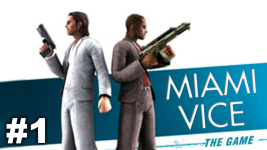
Long train rides, boring lectures, and even late-night sessions under the covers all got an instant upgrade the moment that sleek little handheld powered on.
For a lot of us, Miami Vice: The Game was one of those titles that turned the PSP into more than just a gadget, it was a gateway into neon-soaked shootouts and undercover drama.
Ever catch yourself scrolling through today’s endless wave of hyper-realistic games and thinking, “Man, they just don’t make them like they used to”? You’re not alone.
That itch to revisit the past, to feel the weight of a clunky UMD case in your hand or hear the whir of the disc spinning inside, hits hard sometimes. And when it does, games like Miami Vice: The Game suddenly shine brighter than their original reviews ever gave them credit for.
I still remember playing as Crockett, ducking behind cover and trying to outsmart Sacrenegra’s cartel, all while juggling drug deals like some reckless Wall Street broker in flip-flops. It was rough around the edges, sure, but it had charm. The kind of charm that makes you grin when you stumble across it years later.
That’s the journey we’re diving into here: the flawed brilliance, the cult nostalgia, and why this forgotten shooter is suddenly finding love again. Buckle up, because Vice City’s heat hasn’t cooled one bit.
North America saw its release on July 18, followed closely by Europe on July 21, and Australia a couple of weeks later on August 3. Rebellion Developments handled the creation, while Vivendi Universal Games took charge of publishing. Unlike many crime-action titles of the time, this one was exclusive to the PSP, which added to its mystique but also limited its reach.
The game wasn’t a random spin-off, it was tied directly to Michael Mann’s 2006 Miami Vice film. The developers leaned on Hollywood branding by using the likenesses of Colin Farrell (Sonny Crockett) and Jamie Foxx (Ricardo Tubbs).
That connection to big-screen stars gave the handheld title extra weight, even if the gameplay didn’t always live up to the cinematic flair.
The timing of its release was interesting. In 2006, the handheld battle was raging: Sony’s PSP versus Nintendo’s DS. The DS leaned on quirky innovations like dual screens and stylus-based controls, while the PSP aimed for sleek graphics and a “console in your pocket” feel.
Tie-in games were everywhere, with studios scrambling to cash in on movie hype. Miami Vice: The Game slipped right into that wave, hoping to ride the buzz of the film into gamers’ hands.
Reception was lukewarm. Metacritic scored it a 63/100, calling it average. Famitsu gave it a 28/40 in Japan. Some reviewers praised its ambition (like the unusual drug economy mechanic) while others felt it lacked polish. GameSpot scored it a 7.3, while the Official U.S. PlayStation Magazine was harsh with a 3/10.
Sales numbers were never blockbuster; the game ended up as more of a cult curiosity than a mainstream hit.

In the game, he carried over the same traits that defined him in the film and TV show—a calm exterior masking the strain of living undercover. His role in the storyline placed him deep in Sacrenegra’s operations, blending charm with danger. Players stepping into Crockett’s shoes often felt the tension of being a cop pretending to be a criminal.
That mix of style and risk captured the character’s essence, even in the handheld format.

His loyalty to Crockett was his anchor, but Tubbs also had his own tactical edge. In gameplay, switching to Tubbs offered slight differences in missions and play style, making the partnership more than cosmetic. Seeing Jamie Foxx’s likeness on a small PSP screen added credibility and star power.
Fans who loved the film enjoyed the sense that their handheld was carrying a piece of Hollywood inside it.
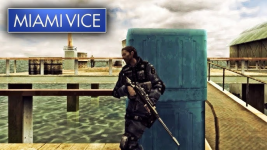
He wasn’t just a faceless target; his character symbolized the untouchable kingpins that defined the crime stories of the ’80s and ’90s. By keeping him hidden behind layers of operations, the game mirrored the real-life frustration of law enforcement who could never quite pin down cartel leaders.
The story world was fleshed out with informants and small-time dealers who weren’t just filler; they were gameplay devices. Informants traded crucial information in exchange for drugs, which was a risky twist for a licensed title. At the police station, hacking FlashRams opened up new leads and tools, keeping the momentum alive between missions.
These smaller roles reinforced the sense of being part of a bigger network, where every player choice rippled through the case.

The informant dealers were rough around the edges, often sketched as street-level hustlers. They weren’t central to the story’s drama, but they shaped the gameplay in surprising ways. By buying or selling drugs with these characters, players unlocked intel that could tip the balance of a mission.
It blurred the line between ally and liability, adding tension to what might otherwise feel like a simple transaction.
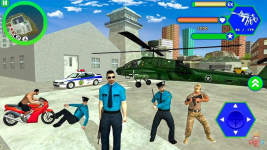
Officers and tech specialists gave the world a procedural feel. These background characters weren’t as memorable as Crockett or Tubbs, but they framed the narrative, reminding players that undercover work still tied back to a larger institution.
They also played a role in the FlashRam hacking mini-games, setting up the justification for those quirky arcade-style puzzles.
While faceless in personality, their presence painted the world as dangerous and unpredictable. The sheer number of henchmen gave players the sense of taking on an entire empire, not just a single kingpin.
In many ways, they represented the endless cycle of crime that Crockett and Tubbs were up against.
Their fear, indifference, or occasional helpfulness made the Miami setting feel alive. It wasn’t a polished open world like GTA: Vice City, but these smaller touches reminded players they weren’t operating in a vacuum.
Missions dropped players into hostile environments filled with Sacrenegra’s men, and survival depended on smart positioning. Staying out in the open was a death sentence; the game pushed players to hug cover, pop out to fire, then duck back before health drained too quickly. Every firearm came with laser sights, which worked as your aiming reticule.
It gave shootouts a slick, precise feel; even if the PSP’s small screen made the chaos harder to manage at times.
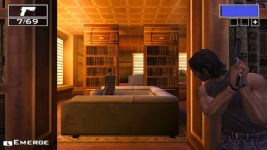
Players could buy drugs from certain suppliers and hold onto them for days in-game, hoping their value would rise. Selling at the right moment could turn a tidy profit. It wasn’t just about money, though—informants often demanded drugs in exchange for intel. This mechanic was daring for a licensed title and added a strategic layer that went beyond standard run-and-gun action.
It made you think like both a cop and a hustler, which mirrored the blurred lines Crockett and Tubbs walked in the story.
Back at the police station, these could be hacked in a mini-game resembling a retro arcade shooter. You had to destroy boxes that shot back at your icon, with each FlashRam containing three escalating difficulty levels.
Rewards weren’t trivial; successful hacks unlocked upgrades, highlighted dealer locations, and improved your arsenal. It was a playful, old-school diversion inside a gritty crime narrative.
Each had its own strengths, but upgrades were where things got interesting. You could boost magazine size, tighten accuracy, and crank up damage. Unlocking every upgrade opened access to the notorious “Coke Head Mode.” Activated with the Triangle button, this mode doubled movement and firing speed but slashed health by half and wrecked aiming precision.
It was risky, chaotic, and exactly the kind of over-the-top feature fans loved to experiment with.
Buying suits wasn’t just cosmetic; it boosted your reputation in-game, subtly affecting how the underworld perceived you. Armor gave you more breathing room in firefights, but it was expensive, forcing players to weigh style against survival.
That constant balancing act kept progression engaging, even if critics felt it wasn’t as deep as it could have been.
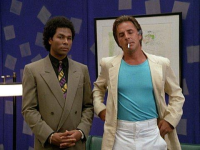
Airing through the mid-to-late ’80s, Miami Vice became iconic for its neon palette, stylish suits, and a soundtrack that practically defined the decade. The game borrowed this DNA; fast cars, undercover cops, and a city that pulsed with both glamour and danger.
Fans of the show noticed echoes in the game’s atmosphere, even if the PSP’s limitations couldn’t capture the sweeping visuals or music that made the series unforgettable.
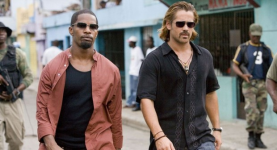
It stripped away some of the flashy ’80s charm and replaced it with a darker, brooding tone. The game served as a prequel to this movie, letting players step into Crockett and Tubbs’ shoes just before the cinematic events.
While the film divided audiences, the game added context and gave handheld players a reason to care about the film’s buildup.

All of these works; TV, film, and games, circle the same themes: loyalty, corruption, and living double lives. What set Miami Vice: The Game apart was its handheld ambition. It didn’t try to rival GTA’s freedom or Scarface’s bombast. Instead, it aimed to deliver a bite-sized, portable taste of Miami’s criminal underworld.
Fans reacted with mixed feelings: some appreciated the novelty, others wished it had gone bigger.
That meant the developers had less time to polish mechanics or expand on ideas. Many critics later noted the uneven quality, but the rush also explains why some experimental features; like the drug economy, felt both daring and half-baked.
It’s a reminder of how movie tie-in deadlines often shaped the games of that era.
Most movie games stuck to safe mechanics, but this one let players profit from cocaine and heroin deals. Parents’ groups raised eyebrows, but for fans, it gave the game an edgy streak that stood out from the usual bland adaptations.
It was an odd case where controversy added to the game’s long-term cult appeal.
It wasn’t marketed, and it wasn’t obvious. Unlocking it meant you had pushed through all firearm upgrades—a grind most casual gamers never finished. The payoff was a wild trade-off: blazing fast speed and fire rate at the cost of health and accuracy.
It was almost like the developers hid a parody of the game’s drug theme inside the mechanics themselves.
Famitsu’s 28/40 score leaned more on the novelty of the mechanics than the graphics. Even the box art varied by region, with subtle changes in color tone and branding.
For collectors, those differences turned an otherwise forgettable release into a curiosity worth hunting.
Players traded save files, shared hacks, and uploaded grainy YouTube clips of missions. In these spaces, the game was less of a “failure” and more of a hidden gem. That underground community kept its memory alive even as mainstream attention faded.
Miami Vice: The Game wasn’t a blockbuster, but it carved a small place in the PSP’s library.
At a time when most handheld shooters played it safe, this one dared to mix gunfights with an economy system. It showed that even licensed tie-ins could experiment, which made it stand out against the sea of rushed adaptations.
For players who craved more than just linear shooting, it proved the PSP had range.
Years later, the game found unexpected love in retro circles. Reddit threads, YouTube walkthroughs, and fan blogs began resurfacing it as a “hidden gem.” For many, it wasn’t about perfect gameplay, it was about remembering the PSP era itself.
Watching grainy mission footage or hearing the menu music instantly pulled fans back to 2006. Nostalgia turned what critics once dismissed into something worth celebrating.
Looking back, it’s easy to see Miami Vice: The Game as a rough draft for mechanics that later flourished.
Reputation systems, side economies, and morally gray choices are now staples of open-world games like GTA V or Cyberpunk 2077. On the PSP, those ideas were ambitious, if underdeveloped. In hindsight, the game feels like an early step toward today’s more complex crime dramas.
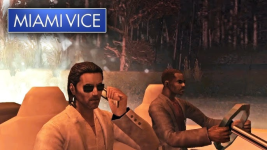
It’s not just nostalgia talking. It’s the memory of a game that dared to be a little messy, a little risky, and a whole lot of fun.
We’ve walked through Crockett and Tubbs’ world, dodged bullets, traded shady deals, and hacked FlashRams like it mattered. We’ve seen how the game wasn’t perfect; but it was bold. It gave us style, danger, and that rush of living double lives, even if just for a few hours on a tiny screen.
That’s the beauty of revisiting Miami Vice: The Game.
It reminds us that gaming isn’t always about flawless mechanics or record-breaking reviews. Sometimes it’s about the thrill of the moment, the grit under the glamour, the way a handheld could make you feel like you were part of something bigger.
We’ve laughed at its quirks, marveled at its ambition, and now we carry that glow with us. The streets of Vice still burn bright in memory, and if you close your eyes, you can almost hear the pulse of the city calling you back.
The game may have ended, but the Vice never really left.
Did you play Miami Vice back then? What do you remember?
Remember when the PlayStation Portable felt like you were carrying a piece of the future in your back pocket?

Long train rides, boring lectures, and even late-night sessions under the covers all got an instant upgrade the moment that sleek little handheld powered on.
For a lot of us, Miami Vice: The Game was one of those titles that turned the PSP into more than just a gadget, it was a gateway into neon-soaked shootouts and undercover drama.
Ever catch yourself scrolling through today’s endless wave of hyper-realistic games and thinking, “Man, they just don’t make them like they used to”? You’re not alone.
That itch to revisit the past, to feel the weight of a clunky UMD case in your hand or hear the whir of the disc spinning inside, hits hard sometimes. And when it does, games like Miami Vice: The Game suddenly shine brighter than their original reviews ever gave them credit for.
I still remember playing as Crockett, ducking behind cover and trying to outsmart Sacrenegra’s cartel, all while juggling drug deals like some reckless Wall Street broker in flip-flops. It was rough around the edges, sure, but it had charm. The kind of charm that makes you grin when you stumble across it years later.
That’s the journey we’re diving into here: the flawed brilliance, the cult nostalgia, and why this forgotten shooter is suddenly finding love again. Buckle up, because Vice City’s heat hasn’t cooled one bit.
Background & Facts about Miami Vice: The Game
Miami Vice: The Game landed on the PlayStation Portable in mid-2006, right when handheld gaming was fighting for mainstream attention.The game wasn’t a random spin-off, it was tied directly to Michael Mann’s 2006 Miami Vice film. The developers leaned on Hollywood branding by using the likenesses of Colin Farrell (Sonny Crockett) and Jamie Foxx (Ricardo Tubbs).
That connection to big-screen stars gave the handheld title extra weight, even if the gameplay didn’t always live up to the cinematic flair.
The timing of its release was interesting. In 2006, the handheld battle was raging: Sony’s PSP versus Nintendo’s DS. The DS leaned on quirky innovations like dual screens and stylus-based controls, while the PSP aimed for sleek graphics and a “console in your pocket” feel.
Tie-in games were everywhere, with studios scrambling to cash in on movie hype. Miami Vice: The Game slipped right into that wave, hoping to ride the buzz of the film into gamers’ hands.
Reception was lukewarm. Metacritic scored it a 63/100, calling it average. Famitsu gave it a 28/40 in Japan. Some reviewers praised its ambition (like the unusual drug economy mechanic) while others felt it lacked polish. GameSpot scored it a 7.3, while the Official U.S. PlayStation Magazine was harsh with a 3/10.
Sales numbers were never blockbuster; the game ended up as more of a cult curiosity than a mainstream hit.
The Faces Behind the Miami Vice
Sonny Crockett (Colin Farrell)
Sonny Crockett was the cool, steady hand of the Miami Vice duo.
In the game, he carried over the same traits that defined him in the film and TV show—a calm exterior masking the strain of living undercover. His role in the storyline placed him deep in Sacrenegra’s operations, blending charm with danger. Players stepping into Crockett’s shoes often felt the tension of being a cop pretending to be a criminal.
That mix of style and risk captured the character’s essence, even in the handheld format.
Ricardo Tubbs (Jamie Foxx)
Ricardo Tubbs brought a sharper, more direct energy.
His loyalty to Crockett was his anchor, but Tubbs also had his own tactical edge. In gameplay, switching to Tubbs offered slight differences in missions and play style, making the partnership more than cosmetic. Seeing Jamie Foxx’s likeness on a small PSP screen added credibility and star power.
Fans who loved the film enjoyed the sense that their handheld was carrying a piece of Hollywood inside it.
Villain: Sacrenegra
Every crime drama needs a villain worth chasing, and Miami Vice: The Game gave players Sacrenegra, a South American drug lord.
He wasn’t just a faceless target; his character symbolized the untouchable kingpins that defined the crime stories of the ’80s and ’90s. By keeping him hidden behind layers of operations, the game mirrored the real-life frustration of law enforcement who could never quite pin down cartel leaders.
The story world was fleshed out with informants and small-time dealers who weren’t just filler; they were gameplay devices. Informants traded crucial information in exchange for drugs, which was a risky twist for a licensed title. At the police station, hacking FlashRams opened up new leads and tools, keeping the momentum alive between missions.
These smaller roles reinforced the sense of being part of a bigger network, where every player choice rippled through the case.
Informant Dealers
Not every face in Miami Vice: The Game was glamorous.
The informant dealers were rough around the edges, often sketched as street-level hustlers. They weren’t central to the story’s drama, but they shaped the gameplay in surprising ways. By buying or selling drugs with these characters, players unlocked intel that could tip the balance of a mission.
It blurred the line between ally and liability, adding tension to what might otherwise feel like a simple transaction.
Police Station Allies
Back at headquarters, the police station acted as more than a menu screen.
Officers and tech specialists gave the world a procedural feel. These background characters weren’t as memorable as Crockett or Tubbs, but they framed the narrative, reminding players that undercover work still tied back to a larger institution.
They also played a role in the FlashRam hacking mini-games, setting up the justification for those quirky arcade-style puzzles.
Street-Level Enforcers
Sacrenegra’s muscle showed up often, serving as the cannon fodder in firefights.While faceless in personality, their presence painted the world as dangerous and unpredictable. The sheer number of henchmen gave players the sense of taking on an entire empire, not just a single kingpin.
In many ways, they represented the endless cycle of crime that Crockett and Tubbs were up against.
Civilians & Background Characters
Though not deeply fleshed out, the civilians wandering the peripheries of missions added atmosphere.Their fear, indifference, or occasional helpfulness made the Miami setting feel alive. It wasn’t a polished open world like GTA: Vice City, but these smaller touches reminded players they weren’t operating in a vacuum.
Miami Vice Gameplay Mechanics & Features
Combat System
At its core, Miami Vice: The Game was a third-person shooter.Missions dropped players into hostile environments filled with Sacrenegra’s men, and survival depended on smart positioning. Staying out in the open was a death sentence; the game pushed players to hug cover, pop out to fire, then duck back before health drained too quickly. Every firearm came with laser sights, which worked as your aiming reticule.
It gave shootouts a slick, precise feel; even if the PSP’s small screen made the chaos harder to manage at times.

Drug Economy Mechanic
One of the most unusual features was the drug-trading system.Players could buy drugs from certain suppliers and hold onto them for days in-game, hoping their value would rise. Selling at the right moment could turn a tidy profit. It wasn’t just about money, though—informants often demanded drugs in exchange for intel. This mechanic was daring for a licensed title and added a strategic layer that went beyond standard run-and-gun action.
It made you think like both a cop and a hustler, which mirrored the blurred lines Crockett and Tubbs walked in the story.
Mini-Games & Hacking
FlashRams scattered across levels gave players a break from constant gunfire.Back at the police station, these could be hacked in a mini-game resembling a retro arcade shooter. You had to destroy boxes that shot back at your icon, with each FlashRam containing three escalating difficulty levels.
Rewards weren’t trivial; successful hacks unlocked upgrades, highlighted dealer locations, and improved your arsenal. It was a playful, old-school diversion inside a gritty crime narrative.
Weapons & Customization
Weapons fell into three broad categories: pistols, shotguns, and machine guns.Each had its own strengths, but upgrades were where things got interesting. You could boost magazine size, tighten accuracy, and crank up damage. Unlocking every upgrade opened access to the notorious “Coke Head Mode.” Activated with the Triangle button, this mode doubled movement and firing speed but slashed health by half and wrecked aiming precision.
It was risky, chaotic, and exactly the kind of over-the-top feature fans loved to experiment with.
Progression & Rewards
Money mattered. Earnings could be funneled into better weapons, fresh suits, or armor.Buying suits wasn’t just cosmetic; it boosted your reputation in-game, subtly affecting how the underworld perceived you. Armor gave you more breathing room in firefights, but it was expensive, forcing players to weigh style against survival.
That constant balancing act kept progression engaging, even if critics felt it wasn’t as deep as it could have been.
Related Works & Comparisons
Miami Vice (1984–1990 TV Series)
The original TV show was where it all started.
Airing through the mid-to-late ’80s, Miami Vice became iconic for its neon palette, stylish suits, and a soundtrack that practically defined the decade. The game borrowed this DNA; fast cars, undercover cops, and a city that pulsed with both glamour and danger.
Fans of the show noticed echoes in the game’s atmosphere, even if the PSP’s limitations couldn’t capture the sweeping visuals or music that made the series unforgettable.
Miami Vice (2006 Film)
Released the same year as the game, Michael Mann’s film went for a grittier realism.
It stripped away some of the flashy ’80s charm and replaced it with a darker, brooding tone. The game served as a prequel to this movie, letting players step into Crockett and Tubbs’ shoes just before the cinematic events.
While the film divided audiences, the game added context and gave handheld players a reason to care about the film’s buildup.
Comparable Games
- True Crime: Streets of LA (2003): Similar undercover cop themes, but more open-world freedom. Where True Crime leaned into branching storylines, Miami Vice: The Game kept its focus narrow and linear.
- Grand Theft Auto: Vice City (2002): Probably the closest cousin. Both games embraced Miami’s neon-soaked underworld. The big difference was scope—GTA’s sprawling sandbox versus Miami Vice’s tighter, mission-based structure. Still, many players couldn’t help but compare the two.
- Scarface: The World Is Yours (2006): Released the same year, also about drugs, crime empires, and revenge. Scarface had a bigger budget and more marketing muscle, but Miami Vice stood out for trying something different with its drug-trading mechanic.

All of these works; TV, film, and games, circle the same themes: loyalty, corruption, and living double lives. What set Miami Vice: The Game apart was its handheld ambition. It didn’t try to rival GTA’s freedom or Scarface’s bombast. Instead, it aimed to deliver a bite-sized, portable taste of Miami’s criminal underworld.
Fans reacted with mixed feelings: some appreciated the novelty, others wished it had gone bigger.
5 Things You Probably Didn't Know about Miami Vice
1. Development Timing
The game was reportedly rushed so it could hit shelves alongside the 2006 film release.That meant the developers had less time to polish mechanics or expand on ideas. Many critics later noted the uneven quality, but the rush also explains why some experimental features; like the drug economy, felt both daring and half-baked.
It’s a reminder of how movie tie-in deadlines often shaped the games of that era.
2. Controversial Mechanics
Including a drug-trading system in a licensed Hollywood tie-in was bold, maybe even reckless.Most movie games stuck to safe mechanics, but this one let players profit from cocaine and heroin deals. Parents’ groups raised eyebrows, but for fans, it gave the game an edgy streak that stood out from the usual bland adaptations.
It was an odd case where controversy added to the game’s long-term cult appeal.
3. Hidden Coke Head Mode
Not every player stumbled across the so-called “Coke Head Mode.”It wasn’t marketed, and it wasn’t obvious. Unlocking it meant you had pushed through all firearm upgrades—a grind most casual gamers never finished. The payoff was a wild trade-off: blazing fast speed and fire rate at the cost of health and accuracy.
It was almost like the developers hid a parody of the game’s drug theme inside the mechanics themselves.
4. Regional Differences
While Western critics hammered the game for mediocrity, Japanese reviewers had a different angle.Famitsu’s 28/40 score leaned more on the novelty of the mechanics than the graphics. Even the box art varied by region, with subtle changes in color tone and branding.
For collectors, those differences turned an otherwise forgettable release into a curiosity worth hunting.
5. Fan Forums & Mod Culture
Long after its release, Miami Vice: The Game found small but vocal fans on PSP forums.Players traded save files, shared hacks, and uploaded grainy YouTube clips of missions. In these spaces, the game was less of a “failure” and more of a hidden gem. That underground community kept its memory alive even as mainstream attention faded.
Miami Vice: The Game wasn’t a blockbuster, but it carved a small place in the PSP’s library.
At a time when most handheld shooters played it safe, this one dared to mix gunfights with an economy system. It showed that even licensed tie-ins could experiment, which made it stand out against the sea of rushed adaptations.
For players who craved more than just linear shooting, it proved the PSP had range.
Years later, the game found unexpected love in retro circles. Reddit threads, YouTube walkthroughs, and fan blogs began resurfacing it as a “hidden gem.” For many, it wasn’t about perfect gameplay, it was about remembering the PSP era itself.
Watching grainy mission footage or hearing the menu music instantly pulled fans back to 2006. Nostalgia turned what critics once dismissed into something worth celebrating.
Looking back, it’s easy to see Miami Vice: The Game as a rough draft for mechanics that later flourished.
Reputation systems, side economies, and morally gray choices are now staples of open-world games like GTA V or Cyberpunk 2077. On the PSP, those ideas were ambitious, if underdeveloped. In hindsight, the game feels like an early step toward today’s more complex crime dramas.

Final Thoughts
Ever find yourself wishing you could fire up that old PSP just to feel the buzz of a neon-lit shootout again?It’s not just nostalgia talking. It’s the memory of a game that dared to be a little messy, a little risky, and a whole lot of fun.
We’ve walked through Crockett and Tubbs’ world, dodged bullets, traded shady deals, and hacked FlashRams like it mattered. We’ve seen how the game wasn’t perfect; but it was bold. It gave us style, danger, and that rush of living double lives, even if just for a few hours on a tiny screen.
That’s the beauty of revisiting Miami Vice: The Game.
It reminds us that gaming isn’t always about flawless mechanics or record-breaking reviews. Sometimes it’s about the thrill of the moment, the grit under the glamour, the way a handheld could make you feel like you were part of something bigger.
We’ve laughed at its quirks, marveled at its ambition, and now we carry that glow with us. The streets of Vice still burn bright in memory, and if you close your eyes, you can almost hear the pulse of the city calling you back.
The game may have ended, but the Vice never really left.
Did you play Miami Vice back then? What do you remember?

